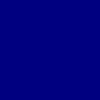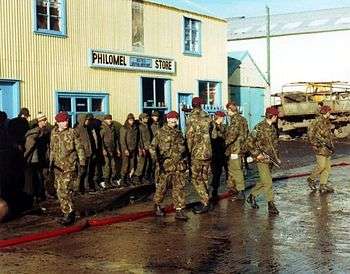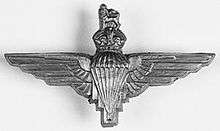2nd Battalion, Parachute Regiment
| 2nd Battalion, Parachute Regiment | |
|---|---|
|
Cap badge of the Parachute Regiment | |
| Active |
1941–1947 1948–Present |
| Country |
|
| Branch |
|
| Type | Airborne forces |
| Role | Air assault infantry |
| Size | Battalion |
| Part of |
Parachute Regiment 16 Air Assault Brigade |
| Garrison/HQ | Colchester Garrison |
| Nickname(s) | Immaculate Second |
| Motto(s) |
Utrinque Paratus (Latin for "Ready for Anything") |
| Commanders | |
| Notable commanders |
Maj Gen John Frost CB, DSO & Bar, MC, DL Lt. Col Herbert 'H' Jones VC, OBE |
| Insignia | |
| Drop zone flash |
 |
The Second Battalion, Parachute Regiment (2 PARA), is a battalion-sized formation of the Parachute Regiment, part of the British Army, and subordinate unit within 16th Air Assault Brigade whose Commanding Officer for the period 2013-2016 was Lieutenant Colonel Oliver Kingsbury OBE.[1]
2 PARA is an airborne light infantry unit capable of a wide range of operational tasks, based at Merville Barracks, Colchester Garrison, England. Personnel regularly deploy outside the United Kingdom on operations and training.
All personnel have completed the Pre Parachute Selection (P Company) course at Depot PARA at Catterick, North Yorkshire (previously Aldershot, Hampshire), entitling them to wear the maroon beret.
History
The 2nd Battalion was formed on 30 September 1941, as the 2nd Parachute Battalion, and later became part of the Army Air Corps. The battalion took part in its first active operation over the night of the 27–28 February 1942, Operation Biting, the raid on Bruneval in France.[2] On 1 August of the same year, the battalion was renamed the 2nd Battalion, the Parachute Regiment.
The battalion was part of the 1st Parachute Brigade, 1st Airborne Division, and fought in the British airborne operations in North Africa, Operation Fustian in Sicily, Operation Slapstick on the Italian mainland and, most famously, the Battle of Arnhem in September 1944.[3]
After the Second World War, the battalion was reformed and served with the 6th Airborne Division in Palestine. It was then amalgamated with the 3rd Parachute Battalion and renamed the 2nd/3rd Battalion and shortly afterwards disbanded. A new 2nd Battalion was formed later the same year by renumbering the 5th (Scottish) Parachute Battalion.[4]
In 1951, the battalion was deployed to Ismaïlia, Egypt, after civil unrest in the region, to protect the Suez Canal.[5] In July 1956, 2 Para went to Cyprus to counter the EOKA insurgency. It then took part in Operation Musketeer in November of the same year as part of 16 Independent Parachute Brigade, landing by sea and occupying El Cap.[6]
In June 1961, as part of an 8,000 strong battle-group, 2 Para was sent to Kuwait to forestall a threatened invasion by Iraq.[7] In early 1965 the battalion was rushed to Singapore in response to a threat of invasion of Borneo by Indonesia. In the following Indonesian Confrontation, B Company repulsed an attack by an Indonesian battalion in the jungle at Plaman Mapu.[8] In March 1969, 2 Para went to the Caribbean island of Anguilla to restore the British administration. The men, who were landed by boat from three Royal Navy frigate (along with 40 police officers) were later awarded the Wilkinson Sword of Peace "for acts of humanity and kindness overseas".[9]
In the 1970s, the battalion was sent to Northern Ireland as part of Operation Banner for the first of many tours.[10]

In 1982, the battalion was part of the force sent to the South Atlantic in Operation Corporate, as part of 3 Commando Brigade.[11] The battalion's men were the first troops from the main assault body to land on the islands. The landing was on the shore at San Carlos Water (codename: Blue Beach).[12] The battalion's first battle was the Battle of Goose Green on 28 May.[13] This was followed by the Battle of Wireless Ridge and then the recapture of Port Stanley.[11]
In August 2001, the battalion was part of the NATO Operation Essential Harvest in Macedonia. This was followed in 2002 by Operation Fingal, in Afghanistan.[14] The battalion also took part in UK operations in Iraq and Afghanistan.
See also
- Red Devils (Parachute Regiment)
- List of battalions of the Parachute Regiment
- Parachute Regiment and Airborne Forces Museum
- List of Second World War British airborne battalions
References
- ↑ ParaData roll call: Lieutenant-Colonel Oliver Kingsbury, OBE
- ↑ see Miller, George (1975). The Bruneval Raid. New York: Doubleday & Company, Inc. ISBN 0-385-09542-2.
- ↑ "Battle of Arnhem". Ministry of Defence. Archived from the original on March 13, 2008.
- ↑ Ferguson, Gregor; Lyles, Kevin (1984). The Paras 1940-1984: British airborne forces 1940-1984. Altrincham: Osprey Publishing. ISBN 0-85045-573-1.
- ↑ "Paras in the Canal Zone". Britains-smallwars.com. 1951-12-11. Retrieved 2013-10-25.
- ↑ "Suez (Operation Musketeer)". ParaData. Retrieved 2013-10-25.
- ↑ "Persian Gulf". ParaData. Retrieved 2013-10-25.
- ↑ "Borneo". ParaData. Retrieved 2013-10-25.
- ↑ "Anguilla (Operation Sheepskin)". ParaData. Retrieved 2013-10-25.
- ↑ "Paras in Northern Ireland". Britains-smallwars.com. Retrieved 2013-10-25.
- 1 2 see Smith, Gordon (2006). A Battle Atlas of the Falklands War 1982 by Land, Sea and Air. Lulu.com. ISBN 978-1-84753-950-2.
- ↑ see Clapp, Michael; Southby-Tailyour, Ewen (1996). Amphibious Assault Falklands: The Battle of San Carlos Water. Naval Institute Press. ISBN 978-1-55750-028-1.
- ↑ see Fitz-Gibbon, Spencer (1995). Not Mentioned in Despatches: The History and Mythology of the Battle of Goose Green. James Clarke & Co. ISBN 978-0-7188-3016-8.
- ↑ "[ARCHIVED CONTENT] ISAF: Photo Gallery - on patrol and at HQ". Operations.mod.uk. Retrieved 2013-10-25.
External links
| Wikimedia Commons has media related to 2nd Battalion, Parachute Regiment. |
- 2 PARA - British Army official website
- "2 PARA commanding officer's website". Archived from the original on 22 October 2009.
